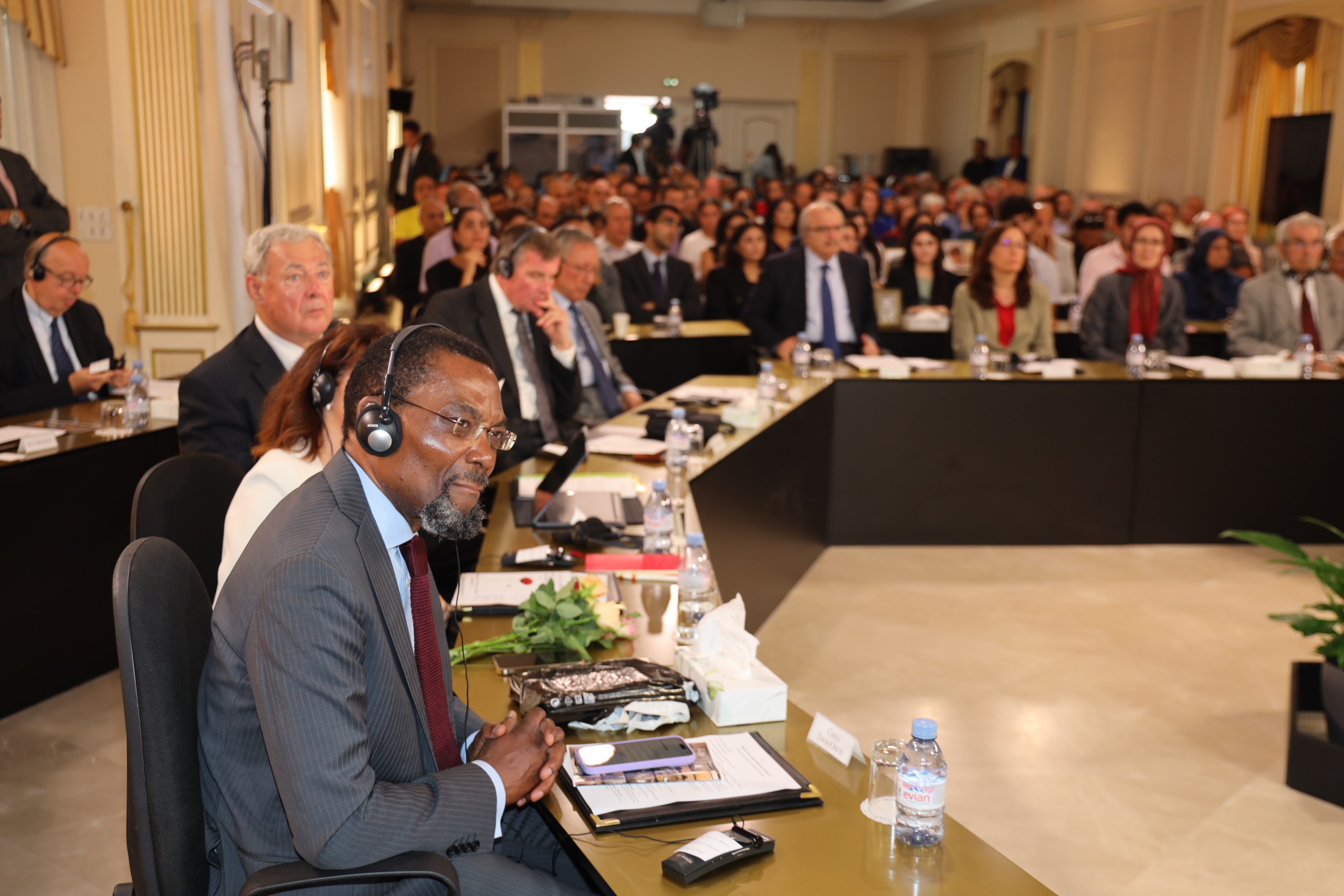Maryam Rajavi’s speech at the conference, entitled “Four Decades of Crime against Humanity and Impunity from Punishment,” on the 35th anniversary of the 1988 massacre

A conference in Paris on Monday, August 21, 2023, marked the 35th anniversary of the 1988 massacre of 30,000 political prisoners in Iran. Entitled, “Four Decades of Crime against Humanity and Impunity from Punishment,” the conference featured some of the most prominent international judges and jurists.
- Chile Eboe-Osuji,President of the International Criminal Court of Hague (2021);
- Leila Nadya Sadat, Special Adviser on Crimes Against Humanity to the ICC Prosecutor (2012-2023);
- Wolfgang Schomburg, Judge of the UN International Criminal Tribunal for the former Yugoslavia (ICTY) and the Judge of the UN International Criminal Tribunal for Rwanda (ICTR);
- William A. Schabas,Chair of the UN Independent Commission of Inquiry on the 2014 Gaza Conflict (2015) and President of the International Association of Genocide (2011);
- Vilenas Vadapalas, Judge of the General Court of the European Union (2013);
- Valerius M. Ciucă, Judge of the General Court of the European Union (2010);
- Oleksandra Matviichuk, Nobel Peace Prize laureate (2022);
- Sir Geoffrey Nice KC, Lead prosecutor at the trial of Slobodan Milošević in The Hague;
- Sheila Paylan, international human rights lawyer and former SGBV Specialist at United Nations human rights office for 15 years;
- the Rt. Hon. David Jones, MP and former UK Secretary of State for Wales;
- Alejo Vidal Quadras, President of the In Search of Justice Committee and Vice President of the European Parliament (1999 to 2014);
- Tahar Boumedra, Director of the Justice for the Victims of the 1988 Massacre in Iran (JVMI) and former Chief of UNAMI Human Rights Office in Iraq (2012), addressed the conference.
Mrs. Maryam Rajavi welcomed the guests and in her opening remarks on the 35th anniversary of the 1988 massacre of political prisoners said, “The moment has arrived to end the impunity enjoyed by the clerical regime’s leaders, shielding them from prosecution and accountability for their participation in genocide and crimes against humanity.”
Following is the text of this speech.
Fellow compatriots, dear guests, greetings to you,
I salute you, the esteemed scholars, jurists, and experts, and supporters of the Iranian Resistance as we gather here to commemorate the anniversary of the tragic massacre that claimed the lives of 30,000 political prisoners, including members of the Mujahedin-e Khalq (PMOI/MEK) and other political groups in Iran.
Thirty-five years ago, during these very days, henchmen acting under Khomeini’s directives massacred PMOI prisoners, which was later followed by the killing of Marxist and other political prisoners. Notably, among the most active perpetrators was the current president of the regime, Ebrahim Raisi.
The passage of 35 years since that horrendous genocide, along with the regime’s attempts to desecrate the graves of the victims, has failed to consign those heroes to oblivion. Undoubtedly, this is the worst massacre of political prisoners since the end of the Second World War, whose masterminds and perpetrators have remained unpunished.
Each victim was selfless, dedicated, and beloved in their respective hometowns.
Each had valiantly resisted in Khomeini’s prisons from five to seven years, enduring vicious torture. Each had steadfastly chosen a noble cause: to build a free, progressive, and equitable society, one free from ignorance, oppression, coercion, and injustice.
The movement of those who stand their grounds
When they were asked to choose between abandoning the ideals of the PMOI and gallows, they consciously, vigilantly, and proudly chose the latter, one by one. They chose their ideal.
According to the confessions of the henchmen, they marched courageously through the corridors of death towards the gallows, their voices echoing with chants of “death to Khomeini, long live freedom, and hail to Massoud [Rajavi].”
These shocking scenes were not confined to the halls filled with nooses. The evil cycle of murder perpetrated by the criminal mullahs has persisted until today, because the Iranian people’s resilience, defiance, and uprisings to overthrow the regime has continued and is continuing today.
Pursuing justice for the victims of the 1988 massacre stands as the moral compass of Iranian society in its ongoing struggle and remains fresh and indelibly etched in the annals of Iranian history.
The parents and survivors of the victims of that massacre continue to search for the resting places of their loved ones. Their thoughts are consumed by the haunting memories of their children’s final moments and what they left behind. They think of their watches, deliberately broken to mark the exact moment of their execution. Indeed, they will neither forgive, nor forget.
At that time, Khomeini ordered the execution of anyone who stood their ground and supported the cause of the PMOI. Little did he anticipate that “standing one’s ground” would evolve into a code word of Resistance, dignity, and freedom.
Salutations to those heroes and the blood-soaked path they trod upon.
Executed for their ideals
Dear friends,
The legal categorization of the massacre that claimed the lives of 30,000 political prisoners falls squarely within the scope of your expertise, esteemed jurists.
All available reports unequivocally attest that more than 90 percent of those tragically killed were affiliated with the PMOI. Eight years before the 1988 massacre, the regime’s senior clerics openly invoked Khomeini’s decree, asserting that supporters and members of the PMOI were not entitled to the right to life, possessions, or assets.
Khomeini perceived the PMOI as an existential threat to his regime’s religious and political essence. This perception stemmed from the fact that the PMOI rejected Khomeini’s regressive interpretation of Islam and refused to submit to his autocratic rule founded on the supremacy of a single jurist. Instead, the PMOI advocated for an Islam that championed freedom and equality.
In Khomeini’s perspective, the survival of the theocratic dictatorship of Velayat-e Faqih rested upon eliminating those who held such beliefs. That’s why, in his decree for mass execution, he wrote that the members of the PMOI are apostates and anyone who stands by this position must be executed.
He wanted to eradicate this movement and its ideology. In protest, Hossein Ali Montazeri, Khomeini’s then-designated successor, wrote that the PMOI is a logical construct; by killing them, they don’t disappear but rather proliferate.
Khomeini seriously felt the danger when he saw Iranian youths extensively joining the PMOI. Therefore, in a public address on June 25, 1980, Khomeini reiterated, “Our adversaries are not in the US, the Soviet Union, or Kurdistan. They are present right here before our eyes, in Tehran.
Ultimately, in the summer of 1988, Khomeini unleashed a widespread massacre in Tehran and more than 130 cities throughout Iran.
Among the pivotal documents concerning this matter is Khomeini’s chilling decree, which you just saw in the exhibition hall. The principal directive of this edict was as follows: Individuals imprisoned throughout the nation, who have demonstrated and continue to exhibit steadfastness in standing their ground, and defending the PMOI, are sentenced to death.
Based on this, each of the massacre victims was executed not because of their actions, but due to their commitment to their beliefs, goals, and ideals.
No trial was held for the execution of any of them. It was enough for the “Death Commission” to determine that a prisoner still held their stance. Many PMOI supporters outside the prisons were also arrested and executed during the same time span. There’s no doubt that the objective of this massacre was the complete eradication of a political and social movement.
According to this decree, not only do the PMOI lives have no sanctity, but even their martyrs are deprived of having tombstones.
The executed were mostly buried in mass graves, and parents, children, and spouses are unaware of their loved ones’ burial places. Dozens of these mass graves have been identified. However, the regime is attempting to destroy even these mass graves, including those in the Khavaran cemetery, in an effort to erase evidence of this heinous crime. Over the past four decades, Khomeini’s decree has been the basis for every atrocity committed against the PMOI.

The regime sought to eliminate the Resistance movement
Years after the massacre, the current regime’s president, Ebrahim Raisi, stated that anyone affiliated with this organization, meaning anyone who holds this ideal, is condemned to execution. Four years ago, Mostafa Pour-Mohammadi, a member of the “Death Commission” during the 1988 massacre and a former interior and justice minister of the regime, said, “We have not yet settled our score with the PMOI.”
For the past four decades, the regime’s central slogan has been “Death to the Hypocrites.” This chant is echoed without fail at every official ceremony. The term “hypocrite” is the regime’s derogatory reference to the PMOI.
In its relations with any country in the world, the regime has declared its most significant red line to be any association with the PMOI.
What prompted the numerous missile attacks, imposition of medical blockades, and execution of handcuffed captives in camps Ashraf and Liberty in Iraq?
Why are the mullahs conspiring against Ashraf-3 in Albania today?
Ashraf-3 accommodates around 1,000 former political prisoners, including witnesses to the 1988 massacre. They are the symbol of four decades of perseverance against this regime and steadfastness in the position of freedom.
The presence of 1,000 combatant women who have defied the mullahs’ oppressive fundamentalism both within Iran and abroad serves as a source of inspiration for tens of millions of Iranian women targeted by the regime’s relentless oppression.
The regime aims to undermine the fundamental rights of PMOI members in Ashraf-3 through blackmail and disinformation, laying the groundwork for their destruction. On June 20, 2023, their efforts to pressure and intimidate the Albanian government led to an unwarranted assault on Ashraf-3, leading to the tragic death of one PMOI member and leaving hundreds injured.
Indeed, for what purpose has the Iranian regime’s Judiciary issued arrest warrants for more than 100 officials and members of this resistance who have been refugees in various European countries, including Albania, for years?
Clearly, the objective, once again, is to fabricate cases to exert pressure and pave the way for their assassination. The main goal remains the same as the 40-year-old objective: to annihilate the resistance movement and counteract Ashraf-3, which stands as a symbol of standing one’s ground in contemporary history.
Luminous trailblazers guide rebels seeking freedom
Today, 35 years later, the regime’s theorists say, “We must recognize that the issue of the People’s Mujahedin is today’s issue.” They state: “We must act so that today’s generation of youth are not inclined to join the organization.”
Khomeini and his regime failed in their attempt to suppress resistance and revolt, and they could not make oppression and misery the eternal destiny of the Iranian people.
Now, these enlightened children of Iran are, in the words of Massoud Rajavi, “writing the destiny of Iran by their uprisings and through sacrifice and struggle in the battlefield.”
The victims of the 1988 massacre, who marched resolutely towards the gallows, are the luminous trailblazers for rebels seeking freedom.
Today, the Call for Justice Movement illuminates their sacrificial flames and guides a generation that stands in the footsteps of those martyrs towards uprising and overthrow.
The Call for Justice Movement is one where the blood of the steadfast victims of the 1988 massacre, the 1,500 martyrs of the 2019 uprising, and the 750 martyrs of the 2022-2023 uprising constantly roars, inspiring people to stand firm, rise, and fight. This movement will carry on until the regime is overthrown.
On a global scale, the moment has arrived to end the four-decade-long impunity enjoyed by the clerical regime’s leaders, shielding them from prosecution and accountability for their participation in genocide and crimes against humanity.
Khamenei, Raisi, and Ejeii, along with other architects of the 1988 massacre and instigators of the killing of young protesters during the recent uprisings in Iran, particularly the commanders of the IRGC, must be prosecuted by an international court.
The supreme leader, president, head of the judiciary, parliamentary speaker, IRGC commanders, and heads of intelligence and security services within the clerical regime have all been implicated in crimes against humanity dating back to the early years of the regime’s rule.
The prosecution of these criminals sends a resounding message of justice and accountability to our global society.
The people of Iran neither forgive nor forget. They draw the day of reckoning ever closer. The day of freedom for the Iranian people, illuminated by the struggle and resilience of Iran’s selfless and brave generations, is approaching like the inevitable rise of the sun.
Thank you all very much!
- Tags: 1988 Massacre, Human Rights, Iran

